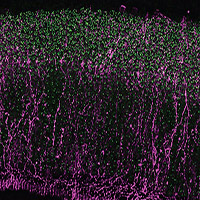Wnt9a induces cell fate changes and rewiring of neurites into the chicken cochlea.
09-21-2017

The Fekete lab published an article on how Wnt9a induces cell fate changes and rewiring of neurites into the chicken cochlea. This manuscript by Munnamalai et. al. was a featured article in the September issue of the Journal of Neuroscience and was also featured on the front cover. The image displays the neurite patterning of afferent pre-synaptic ribbons in hair cells (green) and efferent neurites (magenta).
Misexpression studies showed that when over expressed, Wnt9a increases the number of tall hair cells, one of two types of mechanosensory hair cells that detect sound, while decreasing short hair cells. Wnt9a over expression also affected the re-wiring of afferent and efferent axons indicating that Wnt9a is an important signaling molecule that influences innervation across the radial axis. This in-depth manuscript was a collaborative effort across 3 institutions. The Fekete lab also actively trains a ‘gaggle’ of undergraduate students, three of whom are co-authors on this publication. Karen Song, Kristin Leuthy and Eric Traub were former undergraduate students who contributed in quantifying data.